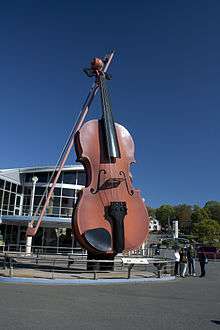Cape Breton fiddling
Cape Breton fiddling is a regional violin style which falls within the Celtic music idiom. Cape Breton Island's fiddle music was brought to North America by Scottish immigrants during the Highland Clearances. These Scottish immigrants were primarily from Gaelic-speaking regions in the Scottish Highlands and the Outer Hebrides. Although fiddling has changed considerably since this time in Scotland, it is widely held that the tradition of Scottish fiddle music has been better preserved in Cape Breton.

Dance styles associated with the music are Cape Breton step dancing, Cape Breton square dancing (Iona style and Inverness style), and highland dancing.
In 2005, as a tribute to the area's traditional music, the construction of a tourism center and the world's largest fiddle and bow was completed on the Sydney waterfront.
Playing style
Cape Breton playing is highly accented, characterized by driven up-bowing. The tunes of other music origins (Irish, Canadian, French-Canadian, etc.) sound quite different when performed by Cape Breton players. The strong downbeat pulse is driven by the fiddler's heel into the floor. The pattern tends to be heel-and-toe on reels, the heel on strathspeys.
Cape Breton fiddle music is strongly influenced by the intonations of the Scots-Gaelic language, especially Puirt a Beul (mouth music) and strathspeys. The ornaments are adapted from those used on the Great Highland bagpipe. The ornamentation (cuts aka. trebles, drones and doubling) brings out the strong feeling of Cape Breton fiddle.
A century ago the violin and pump organ were the common instruments; the latter has been supplanted by piano.
Repertoire
The types of tunes commonly associated with Cape Breton fiddling are jigs, reels, marches, strathspeys, clogs (hornpipes), and slow airs. Many of the tunes associated with Cape Breton fiddle music are also commonly performed on other instruments, especially bagpipes, piano and guitar. It is not unheard of for the music to be performed on harmonica, tin whistle, mandolin or banjo.
Modern Cape Breton players draw on a large body of music, from the Scottish and Irish traditions, and from modern compositions. Several older books of tune collections have been particularly popular sources:
- Fraser, Simon (1874), Simon Fraser Collection
- MacDonald, Keith Norman (1887), The Skye Collection
- MacQuarrie, Gordan F. (1940), The Cape Breton Collection
- O'Neill, Francis (1903), O'Neill's Music Of Ireland
- Robertson, James Stewart (1884), The Athole Collection
- Skinner, James Scott, The Scottish Violinist
- Skinner, James Scott, The Harp and Claymore
A number of recent publications also document a substantial amount of the modern Cape Breton repertoire:
- Beaton, Kinnon (2000), The Beaton Collection (compositions of Kinnon, Donald Angus, and Andrea Beaton)
- Cameron, John Donald (2000), The Heather Hill Collection (compositions of Dan R. MacDonald)
- Cameron, John Donald (1994), The Trip To Windsor Collection (compositions of Dan R. MacDonald, volume 2)
- Cranford, Paul (2007), The Cape Breton Fiddlers Collection
- Cranford, Paul (1997), Winston Fitzgerald: A Collection of Fiddle Tunes
- Dunlay, Kate, and David Greenberg (1996), The Dungreen Collection - Traditional Celtic Violin Music of Cape Breton
- Holland, Jerry (1988, several revised editions), Jerry Holland's Collection of Fiddle Tunes
- Holland, Jerry (2000), Jerry Holland: The Second Collection
- MacEachern, Dan Hugh (1975), MacEachern's Collection
- Ruckert, George (2009), John Campbell: A Cape Breton Legacy
- Stubbert, Brenda (1994), Brenda Stubbert's Collection of Fiddle Tunes
- Stubbert, Brenda (2007), Brenda Stubbert: The Second Collection
Composers and performers
Scottish composers popular in Cape Breton include: Niel Gow, Nathaniel Gow, William Marshall, and James Scott Skinner. Well known Cape Breton composers include: Donald Angus Beaton, Kinnon Beaton, Angus Chisholm, Paul Cranford, Jerry Holland, Dan R. MacDonald, John MacDougall, Dan Hughie MacEachern and Brenda Stubbert.
Cape Breton fiddle music has received international recognition through the careers of Ashley MacIsaac, Natalie MacMaster and The Rankin Family. Other performers of the traditional Cape Breton style include Rodney MacDonald, Andrea Beaton, Winnie Chafe, Winston (Scotty) Fitzgerald, Kimberley Fraser, Carl MacKenzie, Howie MacDonald, Sandy MacIntyre, Buddy MacMaster, Mairi Rankin.
Notable fiddlers
- Donald Angus Beaton
- Kinnon Beaton
- Angus Chisholm
- J. P. Cormier
- Winston "Scotty" Fitzgerald
- Glenn Graham
- Jerry Holland
- Bill Lamey
- Dan R. MacDonald
- Rodney MacDonald
- Sandy MacIntyre
- Ashley MacIsaac
- Dave MacIsaac
- Buddy MacMaster
- Natalie MacMaster
- Brenda Stubbert
See also
- Canadian fiddle
- The Barra MacNeils
- Slainte Mhath
- Violin musical styles—fiddle
- Music of Nova Scotia
- Music of Canada's Maritimes
- Gaelic College of Celtic Arts and Crafts
- Dan R. MacDonald
- Ashley MacIsaac
References
Further reading
- MacGillivray, Allister (1981), The Cape Breton Fiddler, College of Cape Breton Press. ISBN 0-920336-12-4.
External links
- Kimberley Fraser's Fiddle Blog Cape Breton Fiddler Kimberley Fraser discusses issues relevant to Cape Breton fiddle music.